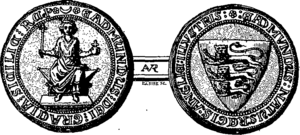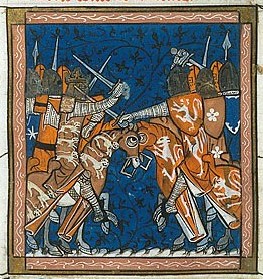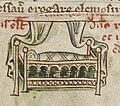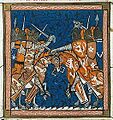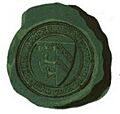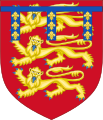Edmund Crouchback facts for kids
Quick facts for kids Edmund Crouchback |
|
|---|---|
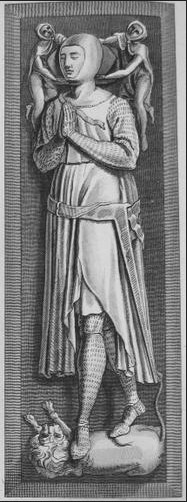
Effigy and monument of Edmund Crouchback, Westminster Abbey
|
|
| Earl of Lancaster, Leicester, and Derby | |
| Predecessor | None (position established) |
| Successor | Thomas of Lancaster |
| Born | 16 January 1245 London, England |
| Died | 5 June 1296 (aged 51) Bayonne, Duchy of Aquitaine |
| Burial | 24 March 1301 Westminster Abbey |
| Spouse |
Aveline de Forz
(m. 1269; died 1274) |
| Issue more... |
Thomas, 2nd Earl of Lancaster Henry, 3rd Earl of Lancaster |
| House | Plantagenet (by birth) Lancaster (founder) |
| Father | Henry III of England |
| Mother | Eleanor of Provence |
Edmund, 1st Earl of Lancaster (born January 16, 1245 – died June 5, 1296) was an important member of the royal Plantagenet Dynasty. He founded the first House of Lancaster, a powerful family branch. Edmund was known as Edmund Crouchback. This name probably came from the cross he wore on his clothes during a crusade.
Edmund was the second son of King Henry III of England and Eleanor of Provence. He was the younger brother of King Edward I of England. Edmund was very loyal to his brother and served him as a diplomat and a warrior.
When he was a child, Edmund was offered the chance to become king of Sicily by the Pope. This was called the "Sicilian business." However, his father, King Henry III, could not pay for the army needed. So, the Pope gave the kingdom to Edmund's uncle instead. This situation made many powerful nobles, called barons, very angry with King Henry.
The anger of the barons led to a big fight known as the Second Barons' War. Edmund supported his father, the King. The royal side won the war in 1265. After the war, Edmund received many lands and titles from the defeated barons. He became the Earl of Lancaster, Leicester, and Derby. He was mainly known as the Earl of Lancaster and became one of the most powerful nobles in England.
Later, Edmund went on a crusade to the Holy Land with his brother Edward. After his first wife, Aveline de Forz, died, Edmund married Blanche of Artois. She was a queen and countess in France. Edmund helped govern her lands in France, especially the wealthy region of Champagne.
Edmund also helped his brother Edward conquer Wales. He also worked to solve problems between England and France. In 1293, when there was a big disagreement over the region of Gascony, Edmund tried to make peace. He negotiated a deal where France would temporarily control Gascony. But King Philip IV of France tricked Edmund and Edward, refusing to give Gascony back. This led to war. Edmund led an army to France but became ill and died in 1296. His body was brought back to England and buried in Westminster Abbey.
Contents
Early Life and Challenges
Birth and Childhood
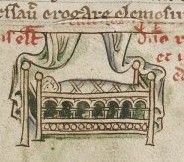
Edmund was born in London on January 16, 1245. His parents were King Henry III of England and Queen Eleanor of Provence. King Henry named him after a saint, Edmund the Martyr, hoping for a second son. Edmund had an older brother, Edward (who became King Edward I of England), and two older sisters, Margaret and Beatrice. He also had a younger sister, Catherine.
Edmund spent much of his childhood at Windsor Castle. He was very close to his father, King Henry, who liked to keep his family near him.
The Sicilian Business
In 1254, when Edmund was nine, his father King Henry III accepted an offer from the Pope. The Pope wanted Edmund to become the next king of Sicily. Sicily was a rich land, and King Henry hoped it would be a great prize for his son. It could also be a base for his planned crusades.
The Pope asked King Henry to send Edmund with an army to take Sicily. Henry also had to pay a large sum of money for the war. Young Edmund even started preparing to be king. He traveled to Gascony with his mother in 1254. In 1255, King Henry formally made Edmund "King of Sicily" in a special ceremony.
However, things went wrong. The new Pope could not help Henry with money. Instead, the Pope demanded that Henry pay back huge debts. King Henry tried to get money from the English Parliament, but they refused. The Pope grew impatient and threatened to punish Henry if he didn't pay. Eventually, the Pope took back the offer of Sicily from Edmund. The title was given to Edmund's uncle, Charles I of Anjou, instead.
The Barons' War
The "Sicilian business" made many English nobles, called barons, very angry with King Henry III. They felt he was wasting money. This anger led to a civil war called the Second Barons' War. The barons were led by Edmund's uncle, Simon de Montfort, 6th Earl of Leicester.
At first, King Henry had to agree to new rules that limited his power. But Edmund worked with his brother Edward and his father to try and get the King's power back. The fighting between the King and the barons went back and forth.
In 1263, a full civil war broke out. Edmund supported his father, the King. He even refused to surrender Dover Castle to the barons. In 1264, the King of France tried to make peace, saying King Henry had the right to rule. But the barons disagreed, and the war continued.
Edmund and his mother went to France to raise an army to help his father. The barons won a big battle at Lewes in May 1264, capturing King Henry and Edward. But Edward escaped. In August 1265, the royal army won a major victory at the Battle of Evesham. Simon de Montfort was killed, and his lands were taken by the King.
Becoming a Powerful Earl
Gaining Titles and Lands
After the King's victory in the Barons' War, Edmund was rewarded. On October 26, 1265, his father, King Henry III, made him the Earl of Leicester. He also received lands from other rebel barons. Edmund returned to England and helped his brother Edward put down the remaining rebels. He gained control of important castles like Cardigan and Carmarthen.
Edmund also received the lands of Robert de Ferrers, 6th Earl of Derby, another rebel baron. Robert had been unreliable during the war. Edmund made it very hard for Robert to get his lands back, so Edmund kept them. When Edward became king, he gave Edmund even more of Robert's former lands, like Chartley Castle.

In 1266, Edmund led an army against rebels hiding in Kenilworth Castle. He helped his father and brother besiege the castle. After a long siege, the rebels surrendered. Edmund then received Kenilworth Castle as his own.
In June 1267, Edmund became the Earl of Lancaster. This was a new title created by his father. He received royal lands in Lancashire and important lordships. Edmund became known primarily by this title. He also gained the Three Castles and Monmouth Castle in Wales. With all these new lands and titles, Edmund became the most powerful noble in England. He was very loyal to his brother Edward, who trusted him completely.
First Marriage and Crusade
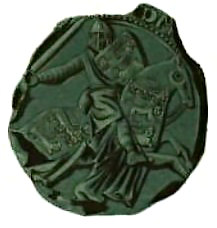
In 1268, Edmund decided to go on a crusade to the Holy Land with his brother Edward. To help pay for this expensive journey, Edmund needed money. His father arranged for him to marry a wealthy lady.
On April 8 or 9, 1269, Edmund married Aveline de Forz at Westminster Abbey. Aveline was only ten years old at the time, so the marriage could not be fully completed until she was fourteen. In the same year, Edmund also became the Earl of Derby, taking over from Robert de Ferrers. This meant he now held the titles of Lancaster, Leicester, and Derby.
Edmund and Edward prepared for the crusade. They finally set sail in 1270. Their original plan was to join the King of France, but he died from illness. Edward continued to the Holy Land, and Edmund joined him in 1271 with more soldiers. They had some small victories, but the crusader forces were too small. A truce was signed in 1272, and the crusade ended. Edmund returned to England.
It was during this crusade that Edmund likely got his nickname "Crouchback." Historians believe it came from "crossback," meaning he wore a cross sewn onto his clothes as a crusader. Later, some people wrongly thought it meant he had a hunchback. But records show Edmund was a handsome and skilled knight.
Second Marriage and French Role
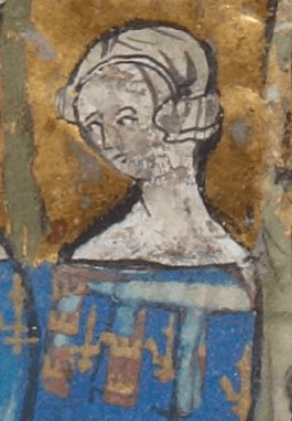
Edmund's father, King Henry III, died in 1272. His brother Edward was proclaimed king, even though he was still returning from the Holy Land. Edmund helped keep peace in England until Edward arrived. In 1273, Edmund's first wife, Aveline, turned fourteen, and their marriage was completed. However, she sadly died in November 1274, leaving Edmund without children.
Edmund's aunt, the Queen Dowager of France, Margaret of Provence, wanted him to marry someone wealthy again. She arranged for him to marry Blanche of Artois. Blanche was the recently widowed Queen Dowager of Navarre and the Countess of Champagne, a very rich region in France. Blanche agreed to the marriage because she needed a husband who was friendly with the King of France to help her manage Champagne.
Edmund and Blanche married in Paris between December 1275 and January 1276. Edmund became a stepfather to Blanche's daughter, Joan. As Joan was still young, Edmund became the count palatine of Champagne. This meant he would govern the county with his wife until Joan was old enough to rule herself. Edmund also became a vassal of the King of France. He brought Blanche to England to see his lands and later visited her kingdom of Navarre.
Commander in Wales and Diplomat
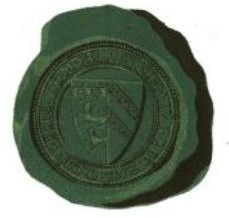
In 1276, relations between England and Wales worsened. Edmund's brother, King Edward I of England, declared war on the Welsh prince Llywelyn ap Gruffudd. Edmund returned to England to join the army. In 1277, he took command of the royal forces in South Wales. He led successful military operations, capturing several castles and the town of Aberystwyth. Edmund helped rebuild Aberystwyth Castle. The war ended in November 1277 with a treaty where Wales gave up control of many lands.
In 1278, Edmund traveled to Champagne to manage his French lands. He also returned to England to attend the wedding of Llywelyn and his cousin, Eleanor de Montfort. In the same year, Edmund and Blanche had their first son, Thomas, who became Edmund's heir.
The next year, King Edward sent Edmund to France as an ambassador. Edmund's job was to negotiate with the King of France about English claims to the regions of Agenais and Quercy. These lands were supposed to return to England. Edmund managed to sign a treaty in May 1279. France gave Agenais to England, but not Quercy. Edmund also helped manage the County of Ponthieu in France for his sister-in-law, Eleanor of Castile.
French Affairs and English Management
In January 1280, a riot broke out in Provins, a town in Champagne, due to an unpopular tax. Edmund and another French noble marched to Provins with an army. They punished the leaders of the riot and took away the town's special rights. Edmund later pardoned the town in 1281 but put a harsh new tax on them. This caused Provins to decline, while Edmund's English town of Leicester grew.
In 1281, Blanche gave birth to Edmund's second son, Henry. Henry's grandson, Henry of Grosmont, would become a very powerful leader in England.
In 1281, Edmund joined other nobles to support his aunt, Margaret of Provence, in her claim to her homeland of Provence. She was fighting against Edmund's uncle, Charles I of Anjou. They planned to invade Provence, but a rebellion in Sicily forced Charles to give Provence to Margaret, avoiding a war.
In May 1282, Edmund heard that Wales had started another war against England. He returned to England to command the English army in South Wales. Edmund's army helped trap and kill the Welsh prince Llywelyn in December 1282. Edward completed his conquest of Wales in 1283.
Ceding Champagne and English Duties
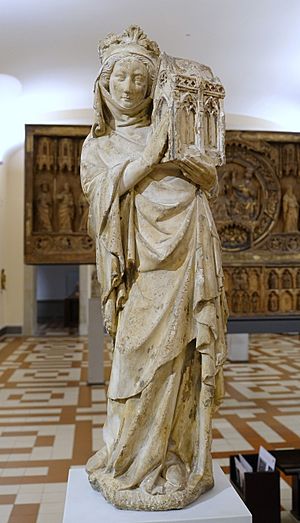
As his stepdaughter Joan approached the age of eleven, which was the age of adulthood in France, Edmund tried to keep control of Champagne for longer. He argued that the laws of Champagne meant she should be twenty-one before taking full control. But the King of France insisted.
When Joan turned eleven in January 1284, Edmund gave up his title as Count Palatine of Champagne. He handed control of the county to Philip the Fair, who was Joan's husband and the son of the King of France. Blanche, Edmund's wife, was allowed to keep some of her castles and lands.
Edmund and Blanche had their last son, John, before May 1286. For the rest of the 1280s, Edmund managed his lands in England. He also spent almost three years in Gascony with his brother King Edward I of England.
In 1290, Edward inherited the County of Ponthieu. Because Edmund had experience managing French lands, Edward gave Ponthieu to Edmund to administer. Edmund would manage it until Edward's son, Edward of Caernarfon, was old enough. In 1291, Edmund was present when Edward helped choose the next King of Scotland. He saw the Scottish nobles promise loyalty to Edward.
In 1292, Edmund was part of a group that set rules for using weapons in the kingdom. He also helped resolve a dispute between two powerful nobles. In 1293, Edmund helped found a convent for nuns called the Abbey of the Minoresses of St. Clare without Aldgate in London. His wife, Blanche, helped bring the first nuns from France. He also helped establish a friary in Preston.
Final Years and War
Crisis with France
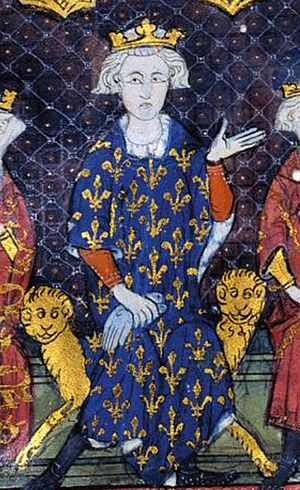
The good relationship between England and France became very bad in 1293. English sailors defeated a French fleet and attacked a French port. King Philip IV of France, who was Edmund's stepson-in-law, was furious. He demanded that King Edward I of England hand over the sailors and pay for the damage. Philip also threatened to take Gascony, a region in France that belonged to Edward.
Edward did not want war. He sent Edmund and other ambassadors to Paris to negotiate with Philip. Edmund traveled to France with his wife, Blanche. At first, Edmund struggled to reach a deal. But Philip's wife, Queen Joan I of Navarre (Edmund's stepdaughter), and the Queen Dowager of France, Marie of Brabant, offered to help.
The queens helped arrange a secret agreement. Edward would marry Philip's half-sister, Margaret. In return, France would occupy Gascony for forty days, and then give it back. Edmund, thinking the deal was done, ordered his officer in Gascony to hand it over to the French. Philip even promised in front of witnesses that he would honor the agreement. However, Edward heard rumors of French betrayal and decided not to visit France, which angered Philip.
When the forty days were over, Edmund asked for Gascony to be returned. Philip gave a negative answer. He claimed he didn't want to upset some of his advisors who opposed giving Gascony back. The English were refused entry to the council meeting. Finally, on April 21, Philip announced that France would keep Gascony. He had tricked Edmund, Blanche, and Edward.
War in France
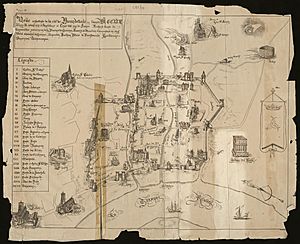
After hearing of Philip's betrayal, Edmund gave up his loyalty to the King of France. He and Blanche sold some of her lands in France. They returned to England, ready for war. Edward formally broke his ties with Philip, and England prepared for battle. In July 1294, Edward told his officers in Gascony that he was sending Edmund and another earl to reclaim the region. Edmund was one of the strongest voices among the nobles calling for war.
Edmund planned to go to Gascony in October, but he fell ill. He finally left England in the winter, bringing his wife Blanche, another earl, and many knights and soldiers. His forces landed in Brittany, France. They looted the countryside after the local people attacked their messengers. The English army then sailed to Gascony.
On March 22, 1296, a castle surrendered to Edmund's forces. Edmund then began his siege of Bordeaux, a major city. On March 28, the French soldiers in Bordeaux tried to surprise attack the English, but the English were ready and fought them off. On March 30, the English broke through Bordeaux's outer wall, but they couldn't get through the inner walls. Edmund then tried to meet a French army nearby, but he couldn't find them. He returned to Bordeaux to continue the siege.
Death and Burial
By this time, Edmund had run out of money to pay his army. Many of his soldiers left him. Edmund and his remaining forces went to Bayonne, where he was welcomed. However, he was troubled by the failure of his campaign.
Edmund became sick on May 13, 1296, and died on June 5. In his will, he asked that his body not be buried until his debts were paid. His body was preserved and kept in a church in Bayonne for six months. Then, it was moved to a convent in London, England. In 1298, his widow, Blanche of Artois, received a third of his lands as her inheritance. On March 24, 1301, Edmund's body was finally laid to rest in an elaborate tomb in Westminster Abbey, near his first wife, Aveline.
Family
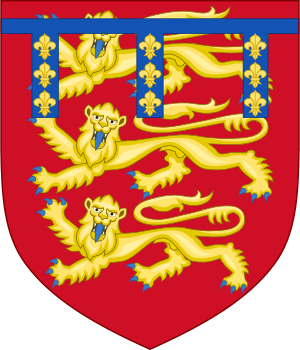
Children
Edmund's first wife, Aveline de Forz, died before they could have any children.
With his second wife, Blanche of Artois, Edmund had four children. Three of his sons lived longer than him:
- Thomas (born around 1278 – died March 22, 1322)
- Henry (born around 1281 – died September 22, 1345)
- John (born before May 1286 – died June 13, 1317)
- Mary, who likely died young in France (no dates recorded)
Through his marriage to Blanche, Edmund also became the stepfather of Queen Joan I of Navarre.
Family Tree
| Ancestors of Edmund Crouchback | |||||||||||||||||||||||||||||||||||||||||||||||||||||||||||||||||||||||||||||||||||||||||||||||||||||||||||||||||||||||||||||||||||||||||||||||||||||||||||||||||||||||||||||||||||||||||||||||||||||||||||||||||||||||||||||||||||||||||||||||||||||||||||||||||||||||||||||||||||||||||
|---|---|---|---|---|---|---|---|---|---|---|---|---|---|---|---|---|---|---|---|---|---|---|---|---|---|---|---|---|---|---|---|---|---|---|---|---|---|---|---|---|---|---|---|---|---|---|---|---|---|---|---|---|---|---|---|---|---|---|---|---|---|---|---|---|---|---|---|---|---|---|---|---|---|---|---|---|---|---|---|---|---|---|---|---|---|---|---|---|---|---|---|---|---|---|---|---|---|---|---|---|---|---|---|---|---|---|---|---|---|---|---|---|---|---|---|---|---|---|---|---|---|---|---|---|---|---|---|---|---|---|---|---|---|---|---|---|---|---|---|---|---|---|---|---|---|---|---|---|---|---|---|---|---|---|---|---|---|---|---|---|---|---|---|---|---|---|---|---|---|---|---|---|---|---|---|---|---|---|---|---|---|---|---|---|---|---|---|---|---|---|---|---|---|---|---|---|---|---|---|---|---|---|---|---|---|---|---|---|---|---|---|---|---|---|---|---|---|---|---|---|---|---|---|---|---|---|---|---|---|---|---|---|---|---|---|---|---|---|---|---|---|---|---|---|---|---|---|---|---|---|---|---|---|---|---|---|---|---|---|---|---|---|---|---|---|---|---|---|---|---|---|---|---|---|---|---|---|---|---|---|---|
|
|||||||||||||||||||||||||||||||||||||||||||||||||||||||||||||||||||||||||||||||||||||||||||||||||||||||||||||||||||||||||||||||||||||||||||||||||||||||||||||||||||||||||||||||||||||||||||||||||||||||||||||||||||||||||||||||||||||||||||||||||||||||||||||||||||||||||||||||||||||||||
| Family tree of the Earls of Leicester, and Earls of Lancaster and Dukes of Lancaster | |||||||||||||||||||||||||||||||||||||||||||||||||||||||||||||||||||||||||||||||||||||||||||||||||||||||||||||||||||||||||||||||||||||||||||||||||||||||||||||||||||||||||||||||||||||||||||||||||||||||||||||||||||||||||||||||||||||||||||||||||||||||||||||||||||||||||||||||||||||||||||||||||||||||||||||||||||||||||||||||||||||||||||||||||||||||||||||||||||||||||||||||||||||||||||||||||||||||||||||||||||||||||||||||||||||||||||||||||||||||||||||||||||||||||||||||||||||||||||||||||||||||||||||||||||||||||||||||||||||||||||||||||||||||||||||||||||||||||||||||||||||||||||||||||||||||||||||||||||||||||||||||||||||||||||||||||||||||||||||||||||||||||||||||||||||||||||||||||||||||||||||||||||||||||||||||||||||||||||||||||||||||||||||||||||||||||||||||||||||||||||||||||||||||||||||||||||||||||||||||||||||||||||||||||||||||||||||||||||||||||||||||||||||||||||||||||||||||||||||||||||||||||||||||||||||||||||||||||||||||||||||||||||||||||||||||||||||||||||||||||||||||||||||||||||||||||||||||||||||||
|---|---|---|---|---|---|---|---|---|---|---|---|---|---|---|---|---|---|---|---|---|---|---|---|---|---|---|---|---|---|---|---|---|---|---|---|---|---|---|---|---|---|---|---|---|---|---|---|---|---|---|---|---|---|---|---|---|---|---|---|---|---|---|---|---|---|---|---|---|---|---|---|---|---|---|---|---|---|---|---|---|---|---|---|---|---|---|---|---|---|---|---|---|---|---|---|---|---|---|---|---|---|---|---|---|---|---|---|---|---|---|---|---|---|---|---|---|---|---|---|---|---|---|---|---|---|---|---|---|---|---|---|---|---|---|---|---|---|---|---|---|---|---|---|---|---|---|---|---|---|---|---|---|---|---|---|---|---|---|---|---|---|---|---|---|---|---|---|---|---|---|---|---|---|---|---|---|---|---|---|---|---|---|---|---|---|---|---|---|---|---|---|---|---|---|---|---|---|---|---|---|---|---|---|---|---|---|---|---|---|---|---|---|---|---|---|---|---|---|---|---|---|---|---|---|---|---|---|---|---|---|---|---|---|---|---|---|---|---|---|---|---|---|---|---|---|---|---|---|---|---|---|---|---|---|---|---|---|---|---|---|---|---|---|---|---|---|---|---|---|---|---|---|---|---|---|---|---|---|---|---|---|---|---|---|---|---|---|---|---|---|---|---|---|---|---|---|---|---|---|---|---|---|---|---|---|---|---|---|---|---|---|---|---|---|---|---|---|---|---|---|---|---|---|---|---|---|---|---|---|---|---|---|---|---|---|---|---|---|---|---|---|---|---|---|---|---|---|---|---|---|---|---|---|---|---|---|---|---|---|---|---|---|---|---|---|---|---|---|---|---|---|---|---|---|---|---|---|---|---|---|---|---|---|---|---|---|---|---|---|---|---|---|---|---|---|---|---|---|---|---|---|---|---|---|---|---|---|---|---|---|---|---|---|---|---|---|---|---|---|---|---|---|---|---|---|---|---|---|---|---|---|---|---|---|---|---|---|---|---|---|---|---|---|---|---|---|---|---|---|---|---|---|---|---|---|---|---|---|---|---|---|---|---|---|---|---|---|---|---|---|---|---|---|---|---|---|---|---|---|---|---|---|---|---|---|---|---|---|---|---|---|---|---|---|---|---|---|---|---|---|---|---|---|---|---|---|---|---|---|---|---|---|---|---|---|---|---|---|---|---|---|---|---|---|---|---|---|---|---|---|---|---|---|---|---|---|---|---|---|---|---|---|---|---|---|---|---|---|---|---|---|---|---|---|---|---|---|---|---|---|---|---|---|---|---|---|---|---|---|---|---|---|---|---|---|---|---|---|---|---|---|---|---|---|---|---|---|---|---|---|---|---|---|---|---|---|---|---|---|---|---|---|---|---|---|---|---|---|---|---|---|---|---|---|---|---|---|---|---|---|---|---|---|---|---|---|---|---|---|---|---|---|---|---|---|---|---|---|---|---|---|---|---|---|---|---|---|---|---|---|---|---|---|---|---|---|---|---|---|---|---|---|---|---|---|---|---|---|---|---|---|---|---|---|---|---|---|---|---|---|---|---|---|---|---|---|---|---|---|---|---|---|---|---|---|---|---|---|---|---|---|---|---|---|---|---|---|---|---|---|---|---|---|---|---|---|---|---|---|---|---|---|---|---|---|---|---|---|---|---|---|---|---|---|---|---|---|---|---|---|---|---|---|---|---|---|---|---|---|---|---|---|---|---|---|---|---|---|---|---|---|---|---|---|---|---|---|---|---|---|---|---|---|---|---|---|---|---|---|---|---|---|---|---|---|---|---|---|---|---|---|---|---|---|---|---|---|---|---|---|---|---|---|---|---|---|---|---|---|---|---|---|---|---|---|---|---|---|---|---|---|---|---|---|---|---|---|---|---|---|---|---|---|---|---|---|---|---|---|---|---|---|---|---|---|---|---|---|---|---|---|---|---|---|---|---|---|---|---|---|---|---|---|---|---|---|---|---|---|---|---|---|---|---|---|---|---|---|---|---|---|---|---|---|---|---|---|---|---|---|---|---|---|---|---|---|---|---|---|---|---|---|---|---|---|---|---|---|---|---|---|---|---|---|---|---|---|---|---|---|---|---|---|---|---|---|---|---|---|---|---|---|---|---|---|---|---|---|---|---|---|---|---|---|---|---|---|---|---|---|---|---|---|---|---|---|---|---|---|---|---|---|---|---|---|---|---|---|---|---|---|---|---|---|---|---|---|---|---|---|---|---|---|---|---|---|---|---|---|---|---|---|---|---|---|---|---|---|---|
|
|||||||||||||||||||||||||||||||||||||||||||||||||||||||||||||||||||||||||||||||||||||||||||||||||||||||||||||||||||||||||||||||||||||||||||||||||||||||||||||||||||||||||||||||||||||||||||||||||||||||||||||||||||||||||||||||||||||||||||||||||||||||||||||||||||||||||||||||||||||||||||||||||||||||||||||||||||||||||||||||||||||||||||||||||||||||||||||||||||||||||||||||||||||||||||||||||||||||||||||||||||||||||||||||||||||||||||||||||||||||||||||||||||||||||||||||||||||||||||||||||||||||||||||||||||||||||||||||||||||||||||||||||||||||||||||||||||||||||||||||||||||||||||||||||||||||||||||||||||||||||||||||||||||||||||||||||||||||||||||||||||||||||||||||||||||||||||||||||||||||||||||||||||||||||||||||||||||||||||||||||||||||||||||||||||||||||||||||||||||||||||||||||||||||||||||||||||||||||||||||||||||||||||||||||||||||||||||||||||||||||||||||||||||||||||||||||||||||||||||||||||||||||||||||||||||||||||||||||||||||||||||||||||||||||||||||||||||||||||||||||||||||||||||||||||||||||||||||||||||||
Images for kids
-
Effigy and monument of Edmund Crouchback, Westminster Abbey
-
Birth of Edmund, 1245. Recorded by Matthew Paris
-
Second Barons' War between Henry III (left) and Simon de Montfort (right)
-
Chartley Castle in Staffordshire, one of the properties Edmund retained from the disgraced baron, Robert de Ferrers, 6th Earl of Derby
-
The Great Keep of Kenilworth Castle in Warwickshire. Edmund received Kenilworth Castle following the Dictum of Kenilworth.
-
Grosmont Castle in Monmouthshire in Wales, one of the Three Castles, which Edmund received from his brother Edward.
-
Edmund's seal (19th-century reproduction by Henri d'Arbois de Jubainville)
-
Blanche of Artois, Edmund's second wife, 1285
-
Seal depicting Edmund's coat of arms as Count Palatine of Champagne
-
Edmund's stepdaughter Joan I of Navarre
-
King Philip IV of France, Edmund's stepson-in-law through his stepdaughter Joan and his cousin first removed through his cousin King Philip III of France
-
A map of Bordeaux in 1229, where Edmund launched his siege
-
Coat of arms of Edmund Crouchback and the House of Lancaster
See also
 In Spanish: Edmundo de Lancaster para niños
In Spanish: Edmundo de Lancaster para niños


